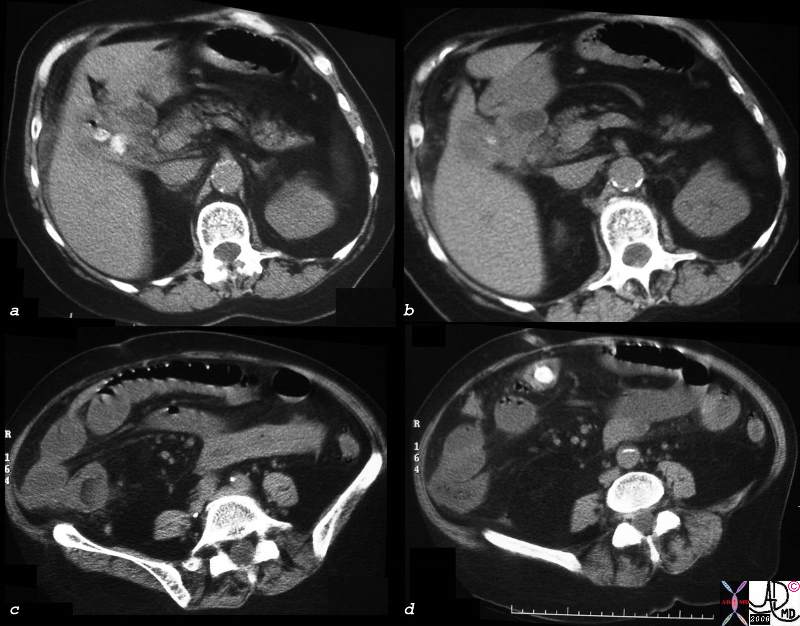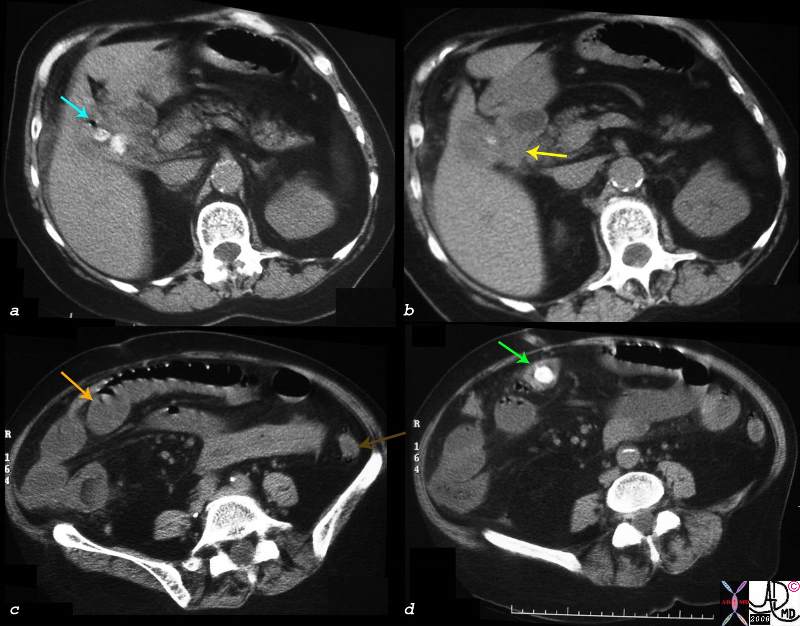The Common Vein Copyright 2008
Alok Anand Ashley Davidoff MD
Definition
Gallstone ileus is an uncommon obstructive disease of the small bowel characterized and caused by a large obstructing gallstone, usually at the ileocecal junction.
Episodes of recurrent calculous cholecysitis, lead to a fistula between the gallbladder and the small bowel, allowing a stone to pass through until it obstructs the small bowel.
It may result in perforation, infection, and sometimes even death. It can also result cholangitis if recurrent gallstones pass into the fistulous tract.
Structurally the close anatomic relationship between the gallbladder, duodenum and the colon, the nature of inflammation to cause adhesion, and if severe to damage tissue and cause fistula forms the basis to understanding this entity. Fistulas form most commonly between the gallbladder and the duodenum, though they may form with the colon as well. Obstruction usually occurs in the ileum.
Functionally the disease is more of a mechanical obstruction than an ileus per se, as motility of the bowel is not affected initially. Once the gallstone enters the bowel, it passes along normally, until a point of narrowing is reached, where an obstruction occurs. Most of the time, gallstones will pass uneventfully.
Clinical presentation is most common in the elderly. Patients will typically have and elevated white count, without elevated liver enzymes or alkaline phosphatase. Patients will have colickly abdominal pain, nausea, vomiting, and a distended abdomen. Hyperactive bowel sounds may be present, with increased tympany on percussion. They may have a recent historyreminiscent of acute cholecystitis or a history of recurrent cholecystitis.
The entity may be diagnosed by a plain film of the abdomen where mall bowel obstruction and a lead point of a large calcification would be noted.
CT though isusually the study of choice when the diagnosis is suspected because it can document the obstruction, identify a transition point, and identify the stone. The finding of air in the gallbladder or in the biliary tree is pathognomonic in the setting of the other findings.
This disease is initially treated by surgical removal of the stone and then repair of fistulous tracts. Cholecystectomy is also required.
 Gallstone Ileus Gallstone Ileus |
| In image a, calcified stones and air in the decompressed gallbladder is noted. In b a stone probably impacted in the neck is seen as an calcification with a fluid collection nearby. In c, dilated smallbowel is noted, and in in d, the gallstone surrounded by thick walled ileum is present. This is a classical radiological presentation of gallstone ileus.
31127c01.8s gallbladder stones air adherent to duodenum small bowel dilatation calcification stone gallstone ileus CTscan Courtesy Ashley DAvidoff copyright 2008 |
 Gallstone Ileus Gallstone Ileus |
| In image a, calcified stones and air (blue arrow) in the decompressed gallbladder is noted. In b a stone probably impacted in the neck is seen as an calcification with the area of the fistula suggested by the yellow arrow. A fluid collection is noted nearby. In c, dilated smallbowel is noted, (orange arrow) and the decompressed descending colon is noted by the brown arrow. In d, the gallstone (green arrow is surrounded by the thick walled ileum. This is a classical radiological presentation of gallstone ileus.
31127c02.8s gallbladder stones air adherent to duodenum small bowel dilatation calcification stone gallstone ileus CTscan Courtesy Ashley DAvidoff copyright 2008 |
References
Unbounded Medicine: Gallstone Ileus
Kirchmayr. “Gallstone ileus: rare and still controversial.” ANZ Journal of Surgery. v. 75. no. 4. 2005. p. 234-8
